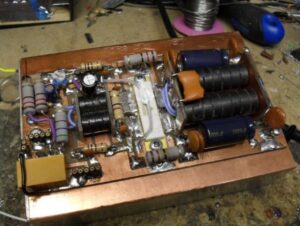M0DGQ described a broadband HF PA in the Wythal Radio Club’s newsletter 2017-01, and rated it at 150W output. Note that this module does not include the necessary output filter which will probably lose 5-10% of the power from this module.
The PA uses a MRF9180 dual MOSFET operating on 26V supply.
Above is the prototype PA. The text states very clearly that the output transformer uses a secondary of two turns of PTFE insulated wire, and the pic above does not provide evidence to the contrary.
Hmmm, experience suggests that may be too few turns. Continue reading Desk study of M0DGQ’s 150W HF PA








